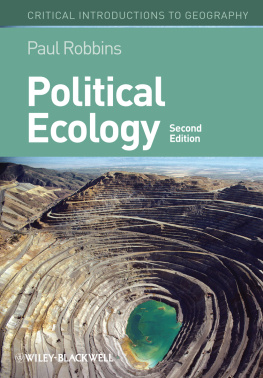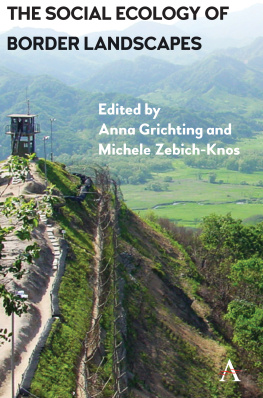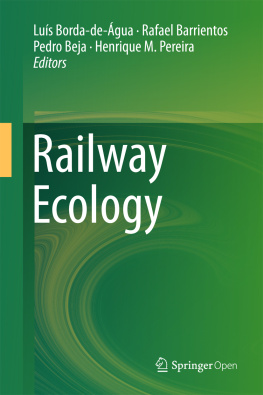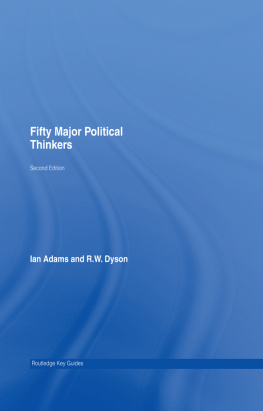
Critical Introductions to Geography
Critical Introductions to Geography is a series of textbooks for undergraduate courses covering the key geographical subdisciplines and providing broad and introductory treatment with a critical edge. They are designed for the North American and international market and take a lively and engaging approach with a distinct geographical voice that distinguishes them from more traditional and out-dated texts.
Prospective authors interested in the series should contact the series editor:
John Paul Jones III
Department of Geography and Regional Development
University of Arizona
Published
Cultural Geography
Don Mitchell
Geographies of Globalization
Andrew Herod
Geographies of Media and Communication
Paul C. Adams
Social Geography
Vincent J. Del Casino Jr
Mapping
Jeremy W. Crampton
Environment and Society
Paul Robbins, Sarah Moore and John Hintz
Research Methods in Geography
Basil Gomez and John Paul Jones III
Political Ecology, Second Edition
Paul Robbins
Forthcoming
Geographic Thought
Tim Cresswell
Cultural Landscape
Donald Mitchell and Carolyn Breitbach
This second edition first published 2012
2012 John Wiley & Sons Ltd
Edition history: Blackwell Publishing Ltd (1e, 2004)
Wiley-Blackwell is an imprint of John Wiley & Sons, formed by the merger of Wileys global Scientific, Technical and Medical business with Blackwell Publishing.
Registered Office
John Wiley & Sons Ltd, The Atrium, Southern Gate, Chichester, West Sussex, PO19 8SQ, UK
Editorial Offices
350 Main Street, Malden, MA 02148-5020, USA
9600 Garsington Road, Oxford, OX4 2DQ, UK
The Atrium, Southern Gate, Chichester, West Sussex, PO19 8SQ, UK
For details of our global editorial offices, for customer services, and for information about how to apply for permission to reuse the copyright material in this book please see our website at www.wiley.com/wiley-blackwell.
The right of Paul Robbins to be identified as the author of this work has been asserted in accordance with the UK Copyright, Designs and Patents Act 1988.
All rights reserved. No part of this publication may be reproduced, stored in a retrieval system, or transmitted, in any form or by any means, electronic, mechanical, photocopying, recording or otherwise, except as permitted by the UK Copyright, Designs and Patents Act 1988, without the prior permission of the publisher.
Wiley also publishes its books in a variety of electronic formats. Some content that appears in print may not be available in electronic books.
Designations used by companies to distinguish their products are often claimed as trademarks. All brand names and product names used in this book are trade names, service marks, trademarks or registered trademarks of their respective owners. The publisher is not associated with any product or vendor mentioned in this book. This publication is designed to provide accurate and authoritative information in regard to the subject matter covered. It is sold on the understanding that the publisher is not engaged in rendering professional services. If professional advice or other expert assistance is required, the services of a competent professional should be sought.
Library of Congress Cataloging-in-Publication Data
Robbins, Paul, 1967
Political ecology : a critical introduction / Paul Robbins. 2nd ed.
p. cm. (Critical introductions to geography)
Includes bibliographical references and index.
ISBN 978-0-470-65732-4 (pbk. : alk. paper)
1. Political ecology. I. Title.
JA75.8.R63 2012
304.2dc23
2011020604
A catalogue record for this book is available from the British Library.
This book is published in the following electronic formats: ePDFs 9781119953340; ePub 9781119953357; mobi 9781119953364
Preface to the Second Edition
The seven years between the first edition and this one have made the relevance and urgency of political ecology a difficult thing to determine. On the one hand, the field has grown so dramatically, and in so many directions, that it is even easier to say of this contested enterprise that it has become too diffuse to matter. References to political ecology in the Web of Science database have more than doubled in the intervening years but now reflect a huge range of approaches. One might think that political ecology has finally jumped the shark, a phrase from the television industry suggesting the creative end of a franchise. I am sympathetic with those who may hurriedly wish to get on with the next thing as well as those who are still not sure what political ecology is, let alone whether it has a purchase on a special kind of explanation.
And yet if political ecology is no longer relevant, no one bothered to tell the world . The horrifying 2004 tsunami revealed structures of vulnerability that demand structural analysis. The summer monsoon of 2010 swept away hundreds of thousands of people in Pakistan, in a floodplain perfectly engineered to reduce the year-to-year hazard of flooding in defense of cash crop production, while increasing the decade-to-decade probability of human tragedy on an unimaginable scale. Areas gazetted for conservation mushroomed in recent years without consensus on how to deal with the displacement of people and loss of productive resources this entails. Mining concessions have ballooned on indigenous land. The world got warmer.
And Hurricane Katrina in 2005 came closer than perhaps any other single event of recent memory to tear back the veil on the structural inequalities of race and class in the United States, which are physically inscribed into the seascape, implicated in the ecological transformation of the coastal zone, and inseparably linked to the technologies that govern the flow of water through the Mississippi delta. That event came closer , but clearly not yet close enough. There is simply no way to pass through that obscure barrier without continuing to research, produce videos on, analyze, ecologically track, and mount soap boxes to shout about the swirling political and economic relationships that dialectically produce levees and slums, soils and dams, tourism and hunger, energy and climate, people and things. I am forced to conclude that there is as much or more need for political ecology now than seven years ago, and the revised version of the book you have in your hands is the result.
Those familiar with the first edition will notice that changes in the book are numerous, but made in a judicious attempt not to throw in the kitchen sink. I have attempted to update examples but many cases continue to draw on the canon from the field. I have added discussions of emerging traditions, including urban ecology and actor-networks, but not to the detail that they might receive elsewhere. Many new boxes have been added, including key recent works, but necessarily at the expense of some important older work. I have added a chapter (Chapter 7) engaging both land change science and the challenge of causal explanation approaches. I have introduced what I observe as a recent fifth thesis in the field, concerning the political-ecological status of non-humans (Chapter 12). But in the largest departure from my original effort, I have tried to stress that political ecology is not a method or a theory, nor even a single perspective. Rather, I suggest, political ecology is an urgent kind of argument or text (or book, or mural, or movie, or blog) that examines winners and losers, is narrated using dialectics, begins and/or ends in a contradiction, and surveys both the status of nature and stories about the status of nature (Chapter 4).








